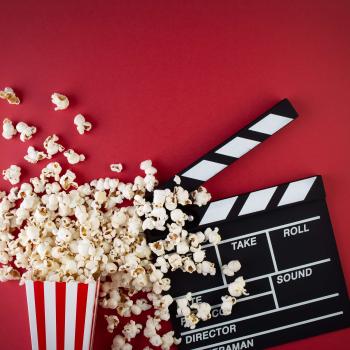You Know the Movie is Coming—Now What?

- Preview |
- Standards |
- Resources & Preparation |
- Instructional Plan |
- Related Resources |
- Comments
Overview
In this lesson, students take on the role of the director of a movie. After exploring cinematic terms, students read a literary work with director's eyes, considering such issues as which scenes require a close-up of the main character and when the camera should zoom out to see the entire set. While reading the text, students record their scenes on a bookmark. All of these activities are completed in anticipation of viewing the movie version of a favorite book.
This lesson uses Charlie and the Chocolate Factory by Roald Dahl as an example; however, the activities can be completed with any matched movie and piece of literature (e.g., any of the Harry Potter books, A Series of Unfortunate Events, or The Polar Express).
Featured Resources
ReadWriteThink Printing Press: Use this online tool to create a newspaper, brochure, booklet, or flyer. Students choose a layout, add content, and then print out their work.
Stapleless Book: Students select page templates and then design pages that can be printed out, cut and folded into an eight-page book.
Flip Book: This online tool allows students to type and illustrate tabbed flip books up to ten pages long.
From Theory to Practice
We know that students are interested in movies and films, but do they have educational value in the language arts classroom? Absolutely! But how can teachers make this experience meet the needs of our curriculum and still have the activity be meaningful for students? There is a natural relationship between literature and films that lends itself to effective classroom activities. As John Golden explains, literature and films "should be used closely together because they share so many common elements and strategies to gain and keep the audience's attention" (36). The shared elements of literature and film create opportunities for students to explore both literary and cinematic elements through their many connections. What students already know about literature informs what they learn about film, and what they already know about film informs what they learn about literature. When students are familiar with the related piece of literature, for instance, they can focus on the cinematic terms and spend less time on the comprehension of the literary text.
Further Reading
Common Core Standards
This resource has been aligned to the Common Core State Standards for states in which they have been adopted. If a state does not appear in the drop-down, CCSS alignments are forthcoming.
State Standards
This lesson has been aligned to standards in the following states. If a state does not appear in the drop-down, standard alignments are not currently available for that state.
NCTE/IRA National Standards for the English Language Arts
- 1. Students read a wide range of print and nonprint texts to build an understanding of texts, of themselves, and of the cultures of the United States and the world; to acquire new information; to respond to the needs and demands of society and the workplace; and for personal fulfillment. Among these texts are fiction and nonfiction, classic and contemporary works.
- 3. Students apply a wide range of strategies to comprehend, interpret, evaluate, and appreciate texts. They draw on their prior experience, their interactions with other readers and writers, their knowledge of word meaning and of other texts, their word identification strategies, and their understanding of textual features (e.g., sound-letter correspondence, sentence structure, context, graphics).
- 4. Students adjust their use of spoken, written, and visual language (e.g., conventions, style, vocabulary) to communicate effectively with a variety of audiences and for different purposes.
- 5. Students employ a wide range of strategies as they write and use different writing process elements appropriately to communicate with different audiences for a variety of purposes.
- 6. Students apply knowledge of language structure, language conventions (e.g., spelling and punctuation), media techniques, figurative language, and genre to create, critique, and discuss print and nonprint texts.
- 8. Students use a variety of technological and information resources (e.g., libraries, databases, computer networks, video) to gather and synthesize information and to create and communicate knowledge.
- 11. Students participate as knowledgeable, reflective, creative, and critical members of a variety of literacy communities.
Materials and Technology
Copies of Charlie and the Chocolate Factory by Roald Dahl, or other texts that have been made into movies
Printouts
Websites
Preparation
- Bookmark this page of cinematic terms or make copies of the film terms handout.
- Make copies or overheads of the sample Text and Film Bookmark and the Bookmark Self-Assessment handout.
- Make copies and cut out the Text and Film Bookmark template for the book that students will read.
- Depending on the policy of your school, you may need to get permission for students to view films with more advanced ratings. If necessary, customize the Permission to View Film/Video, and make copies for students. Ensure that you have signed forms for all students who will view the film in class.
- Test the ReadWriteThink Printing Press, Flip Book, and Stapleless Book on your computers to familiarize yourself with the tools and ensure that you have the Flash plug-in installed. You can download the plug-in from the technical support page.
Student Objectives
Students will
- examine and apply cinematic terms.
- improve comprehension by interpreting, analyzing, synthesizing and evaluating written text.
- categorize text in terms of film terminology as a means of predicting while reading.
Session One
- Ask students to discuss a movie version of a favorite book that will be coming soon to a local theater, using the following questions to guide the discussion:
- What do you most look forward to?
- What scene do you think must be included in the movie?
- What are you afraid the director may leave out?
- What scenes do you think can be left out without affecting the plot?
- Do you think the movie will stay true to the text?
- What do you most look forward to?
- In pairs, ask students to share with each other their experiences of viewing films made from literary texts, using the following questions to shape the conversation:
- How closely did the movie follow the text?
- Was watching the movie version a positive or negative experience?
- How closely did the movie follow the text?
- After the paired discussion, invite volunteers to share some thoughts with the class.
- Direct students the online glossary of cinematic terms, or pass out copies of the film terms handout.
- In pairs or small groups, provide some time for students to read and discuss the glossary.
- Gather the class, and ask students to share some of the terms that were interesting to them as well as any general feedback. Answer any questions the students have about any of the terms.
- Again in pair or small groups, invite students to share examples from movies they have seen where some of these methods have been utilized. Share an example from Charlie and the Chocolate Factory: there should be a low angle shot the first time we meet Willy Wonka.
- Ask students if they know of any books or other texts that are currently being made into a movie. If desired, explore the selected books turned into movies.
- Record the brainstormed list of movies on the board or chart paper.
- Explain the project to students:
- From a list of books made in to movies, you will choose a text to read, as a way of predicting and thinking about the text to the movie.
- Referring to the film terms from the handout or online glossary, read the text with the eye of a movie director.
- Record your thoughts on the bookmark, predicting the decisions that you think the director will make.
- From a list of books made in to movies, you will choose a text to read, as a way of predicting and thinking about the text to the movie.
- Share the directions for the project with the students:
- On the front of the bookmark, write the title, author, and your name. Use the remaining room on the front of the bookmark to recreate the book jacket or draw a scene from their favorite passage.
- On the back of the bookmark, use the available space to predict the decisions you think the director will make, critical scenes you think should be included, and related film terms. Mark the page number of the example and the additional details on the bookmark as you read the text.
- During the activity and once students have finished reading the texts, you’ll share your bookmarks in pairs or small groups. Keep an eye out for similarities and new ideas.
- When the movie is released at the theater or on DVD, we’ll view the movie and compare our bookmarks and cinematic ideas to what actually occurs on the big screen.
- On the front of the bookmark, write the title, author, and your name. Use the remaining room on the front of the bookmark to recreate the book jacket or draw a scene from their favorite passage.
- Share the self-assessment for the bookmark, the bookmark template, and the example Charlie and the Chocolate Factory bookmark.
- Since the project may inspire students, offer several different publishing options:
- Create a bookmark.
- Choose a template from the ReadWriteThink Printing Press.
- Create a Flip Book.
- Make a mini-book using the Stapleless Book.
- Create a bookmark.
- Answer any questions that students have about the project. Since they will be working independently, make sure that they understand the activity before concluding the session.
- Once you’re satisfied that students understand the assignment, they can begin reading the literary work, filling out the bookmark as they read.
- If students are all reading the same book, encourage students to interact with one another, to share and receive feedback.
Session Two
- Continue reading until all texts have been completed, or set a deadline for the reading to be completed.
- Prompt students as they read to fill out their bookmarks with predictions of the director’s decisions, using the film terms the handout or online glossary and examples from the book.
- Remind students to refer to the self-assessment sheet to make sure that they include all the required elements.
Session Three
- When students’ reading is completed and the bookmarks are filled in, gather students to discuss the books that they have read.
- Ask students to share brief summaries of their books (without revealing the ending, of course).
- Ask students to share their bookmarks, which include page numbers of passages from the books that illustrate different film terms.
- When the movies from the project are available, view them as a class.
- Invite the students who read the books to act as moderators.
- Open the floor for discussion, asking students to share their bookmarks and any similarities they found between their predictions and the film.
Extensions
- After viewing the film version of a literary text, invite students to write a movie review. Look at examples of other movie reviews for inspiration and examples of the details that should be included.
- While there are many great texts that have been made into films, there are a number that have not. Invite students to write a play or skit turning their favorite text into a performance.
- Invite students to create DVD covers that illustrate their depiction of a scene using the CD/DVD Cover Creator.
Student Assessment / Reflections
Informal feedback from students who read the bookmarks and search out the related book are excellent feedback for students. For more formal assessment, meet with the students and discuss their Bookmark Self-Assessment sheet, which is tied to the key elements that should be included on the bookmark.
